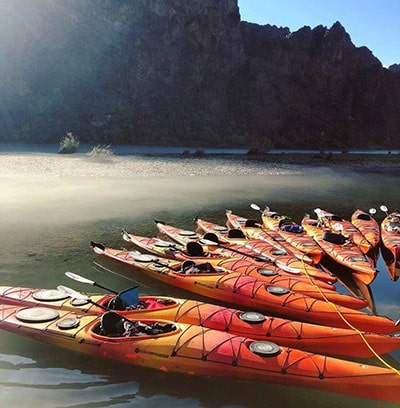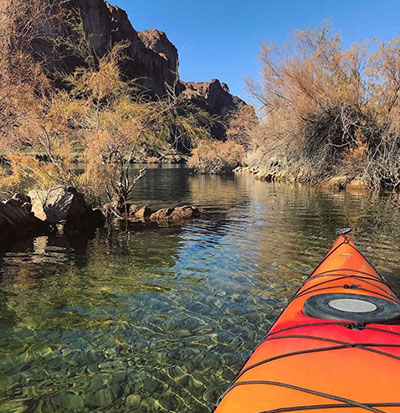A Beginner's Guide to Kayaking Like a Pro
Learning to kayak in Las Vegas has numerous benefits. From meeting like-minded people to simply having the option to get on the water anytime you’d like, there are many great reasons to pick up the sport of kayaking. As with any new endeavor, learning to kayak takes time and practice. Once you get the hang of it, you can safely and confidently make the most of your Colorado River kayaking excursions.
Types of Kayaks
Kayaks come in many forms. They are designed for use in various conditions that range from tranquil waters such as ponds and small lakes to whitewater rapids and the ocean. Some types of kayaks are easier to use than others, which makes them a better option for beginners.
- Sit-on-top
- Touring
- Inflatable
- Tandem
Sit-on-top kayaks are one of the best varieties for beginners. They are wide and have a good center of balance, which makes them sturdy and easy to maneuver out on the water. Sit-on-top kayaks are typically less expensive than other kinds of kayaks. While sit-on-top kayaks are wide and stable, they are also larger and slower than other kayak styles, which makes them a better fit for calmer waters.

Touring kayaks are generally longer and narrower than sit-on-top kayaks. They are also lighter-weight, making them more transportable and faster. Touring kayaks are preferred for more seasoned kayakers or beginners with a good sense of balance. Because they are narrower, touring kayaks are more challenging to get into and out of than sit-on-top kayaks, especially when you’re out on the water.
Inflatable kayaks are suitable for kayakers of all skill levels. They are most useful for people who plan to hike to their kayak launch point, as they can be easily rolled up and tucked away. Inflatable kayaks are best suited for calmer waters, which makes them a good option for novice kayakers.
Tandem kayaks are kayaks made for two people rather than one. Tandem kayaks are available in several styles, including sit-on-top and touring. Tandem kayaks also come in inflatable form.
As you’re deciding what kind of kayak to get, there are several key considerations to think about. First, will you be kayaking by yourself or with another person most of the time? You will also want to think about where you will be transporting your kayak to for launches, and how comfortable you feel loading and unloading the boat by yourself. Then, you’ll want to think about how easy it is for you to get into and out of the boat on your own, both on land and in water. Many kayak retailers will let you test out different boats first to figure out which one you want to get.
Gear and Accessories
To make your kayaking experience as fun and positive as possible, you’ll want to make sure that you have the right gear and accessories along for the ride. Weather can change quickly when you are on the Colorado River kayaking, depending on the time of day and the season. Daytime temperatures can be much warmer than in the evening or early in the morning, so you’ll want to dress in layers or change clothes if you’ll be out on the water for longer periods. The sun can also be strong, which makes sunscreen or sun protection essential. If you bring your phone, camera, wallet, or other valuables for the ride, you’ll want to keep them dry and protected with a waterproof bag or pouch. Wearing polarized sunglasses with ultraviolet (UV) protection is strongly encouraged if your eyes are sensitive to the sun. No matter what you wear, your clothing and footwear should be water-resistant or waterproof.
Personal Flotation Devices
For safety reasons, it is highly recommended that you wear a personal flotation device (PFD) when out on the water. Like kayaks, PFDs are made in various styles to suit the different kinds of water you’ll be kayaking in.
Type I PFDs are heavy-duty flotation devices in rougher water and the ocean. Type II or Type III PFDs are a bit more comfortable. They are not quite as cumbersome as Type I PFDs, which makes them a better choice for calmer waters where you’ll likely be rescued more quickly. While Type I, II, and III PFDs are made specifically for kayaking, you can also get PFDs made for multiple activities, such as Type V. If you get a Type V PFD, ensure that it is suitable for kayaking before purchasing.
Finding a Suitable Time and Location

Once you’ve found the right boat and accessories, it’s time to get in the water. To kayak safely and successfully, you must research places based on your skill and comfort level. Remember that you must find a place accessible to the public, too. Calm waters, which you’ll find on ponds and lakes, are recommended for novice kayakers. Beginners are advised to avoid rivers and oceans as they’re starting due to stronger currents and choppier water. If you are driving to your destination and plan to launch your boat, you’ll also need to figure out parking at the launch spot and determine if there is a launch fee.
No matter where you decide to start your kayaking adventure from, keep an eye on the weather. It’s best to choose a day when skies are clear for maximum visibility. Try to kayak on a day when winds are minimal, and make sure to avoid kayaking if there is a risk of thunderstorms or severe weather in the area.
Blazin’ Paddles | Colorado River Kayaking
Once you’re ready to start, you may wonder, “Where can I learn to kayak near me?” Fortunately, Blazin’ Paddles is here to help you learn. Blazin’ Paddles offers tours for kayakers of all skill levels, a great way to safely learn to kayak Las Vegas and get a feel for what it’s like to be out on the water.
